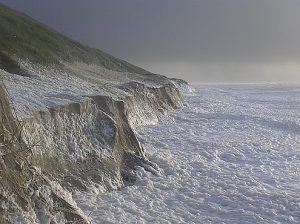
Scientists at Delft University of Technology (TU Delft, The Netherlands) have successfully matched a layer of sediment from the dunes near Heemskerk to a severe storm flood that occurred in either 1775 or 1776. This type of information helps us gain more insight into past storm floods and predict future surges more accurately.
The scientists’ findings have been be published in the online edition of the scientific magazine Geology, and will be cover story of the November paper edition.
Historic knowledge
Our historic knowledge about storm floods (and water levels) on the Dutch coast is relatively limited. Records were not kept consistently until the late nineteenth century. This is unfortunate, because the limited historical archive makes it difficult to formulate statistical conclusions and predictions about future storm floods. It is also harder for us to establish whether storm floods are becoming more severe over the years.
Heemskerk
With the support of Technology Foundation STW and in cooperation with scientists from the Geological Survey of the Netherlands (TNO) and Deltares, scientists at TU Delft have now shown that historic storm-flood data can be augmented using luminescence dating. The team, led by Dr Jakob Wallinga, published their findings in the scientific magazine Geology.
The method was applied to a layer of sediment in the dunes near Heemskerk, created during a storm flood centuries ago and exposed by a storm in 2007. The level to which the storms and waves pushed the water can be deduced from the height of this layer. During the storm-surge in question, the water was higher than the catastrophic flood of 1953.
In order to put these data on a historical timeline, however, it is essential to know when the storm occurred. The scientists have now been able to show that in all probability the layer of sediment was deposited in 1775 or 1776. Historical sources indicate that severe storm floods took place in both years.
Grains of sand
Optical stimulated luminescence was used for the dating procedure. It simply requires a sample of sand from the sediment layer. The technique is based on the phenomenon that grains of sand can emit a faint light signal when they are illuminated with a certain frequency of light. The strength of the luminescence signal grows stronger over time as a result of natural radioactivity (background radiation) from the surroundings. However, the signal is reset to zero when the grains of sand are exposed to sunlight.
The strength of the luminescence signal (and the local strength of the background radiation) indicates the length of time since the grains were last exposed to light; in other words, the moment when they were ‘buried’. Using luminescence dating, a precision of 5% is achievable.
C-14
Luminescence dating requires nothing more than grains of sand, which means it can be used instead of the popular C-14 method at different sites and in different situations. After all, C-14 dating requires organic material. Luminescence dating can be used to date sediment from anywhere between just a few years to over 150,000 years old. It is also used in other disciplines, such as archaeology and art history.
Note : The above story is reprinted from materials provided by Delft University of Technology.










